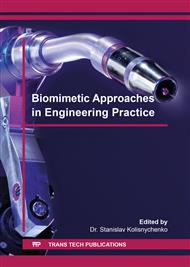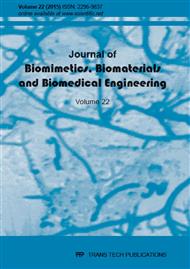p.3
p.13
p.21
p.29
p.37
p.51
p.63
p.77
p.89
Analysis of Statics and Design of Structur Parameters for a Bionic Robot Hip Joint
Abstract:
The hip joint is one of the body's important joints, most of the lower limb activities of the human body are inseparable from the hip joint, a novel bionic robot hip joint was proposed based on 3-DOF spherical parallel mechanism. The statics performance of the bionic robot hip joint was analyzed, and the structure parameters were designed. First, the static transmission equation of the bionic robot hip joint was established using the principle of virtual works, which simplifies the calculation process of the bionic robot hip joint. Further, using the norm in Matrix theory, the force Jacobian matrix was introduced into the statics performance evaluation index, and the statics performance evaluation index and the global torque performance evaluation index was defined, and the performance atlas of the statics performance evaluation index was plotted at the workspace of the bionic robot hip joint. Moreover the objective optimal function was established basing on the global torque performance evaluation index, and the relation of the objective optimal function and the global torque performance evaluation index were analyzed. By use of fully automatic searching method, the optimal structural parameter ranges of the bionic robot hip joint were obtained. Analysis results show that the bionic robot hip joint has good static transmission performance at initial position, and the static transmission performance is decreased with increasing the workspace. Finally, using a set of optimal structural sizes parameters, a novel bionic robot hip joint was designed, which established the theoretical foundation for the bionic robot design and apply.
Info:
Periodical:
Pages:
3-12
Citation:
Online since:
March 2015
Authors:
Keywords:
Price:
Сopyright:
© 2015 Trans Tech Publications Ltd. All Rights Reserved
Share:
Citation:



